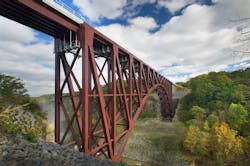No. 4 - Portageville Railroad Bridge
The first Portageville Bridge was constructed in 1852 from timber and burned down shortly after, according to contractor American Bridge Co. In 1875, the original structure was replaced by an iron bridge that consisted of 13 open-deck spans totaling 819 ft carrying a single track 235 ft above the Genesee River Gorge.
Known as one of the nation’s oldest rail bridges, the structure was beginning to cause a bottleneck in the active rail route due to the structural stability of the bridge in recent years. “The condition of the bridge limited rail traffic to 10 mph and did not allow the industry standard 286,000-lb rail cars,” Kevin Johns, P.E., project manager for Modjeski and Masters, told Roads & Bridges. As a result, a new bridge became necessary to replace the troubled structure.
The Portageville Bridge serves as a vital link along the Norfolk Southern Railway Southern Tier Line. The purpose of the new bridge project was to address the existing deficiencies on the Southern Tier rail freight route across the Genesee River by providing a modern rail crossing at its current location capable of carrying current industry standard freight rail loads, while reducing ongoing maintenance and costs.
The new bridge is a single-track, 963-ft-long structure designed to the American Railroad Engineering and Maintenance of Way Association (AREMA) specifications, Norfolk Southern Public Projects Manual and New York State Department of Transportation (NYSDOT) standards. The main span over the Genesee River is a 483-ft, two-hinged spandrel braced steel arch, which varies in depth from 25 ft at the center to 148 ft at the ends.
While a two-hinged spandrel braced arch could make an economical choice that fits the needs for a long span railroad bridge, it is contingent upon having site conditions that can accommodate the thrust forces from the arch. Historically, according to Johns, these conditions have rarely presented themselves, with only about six other examples of spandrel braced railroad arch bridges having ever been built in North America, the most recent of which was in 1925, making the new Portageville Bridge a unique structure in modern history with few comparable peers.
Innovations on the project were necessary in the design and construction processes, particularly since the arch was beyond the guidance of the AREMA manual. Innovative methods also were needed to protect the sensitive environment around the bridge, including native bald eagles often seen in the area. Because of this, a cantilevered construction method was implemented to preclude the need for any falsework in the river and gorge below the arch. In addition, a 3-D finite element analysis of the gorge walls was conducted to determine the potential for differential foundation settlement and for displacement due to the arch thrust.
Location: Portageville, N.Y.
Owner: Norfolk Southern Corp.
Designer: Modjeski and Masters Inc.
Contractor: American Bridge Co.
Cost: $68 million
Length: 963 ft total, 483 ft main span
Completion Date: Aug. 31, 2018
